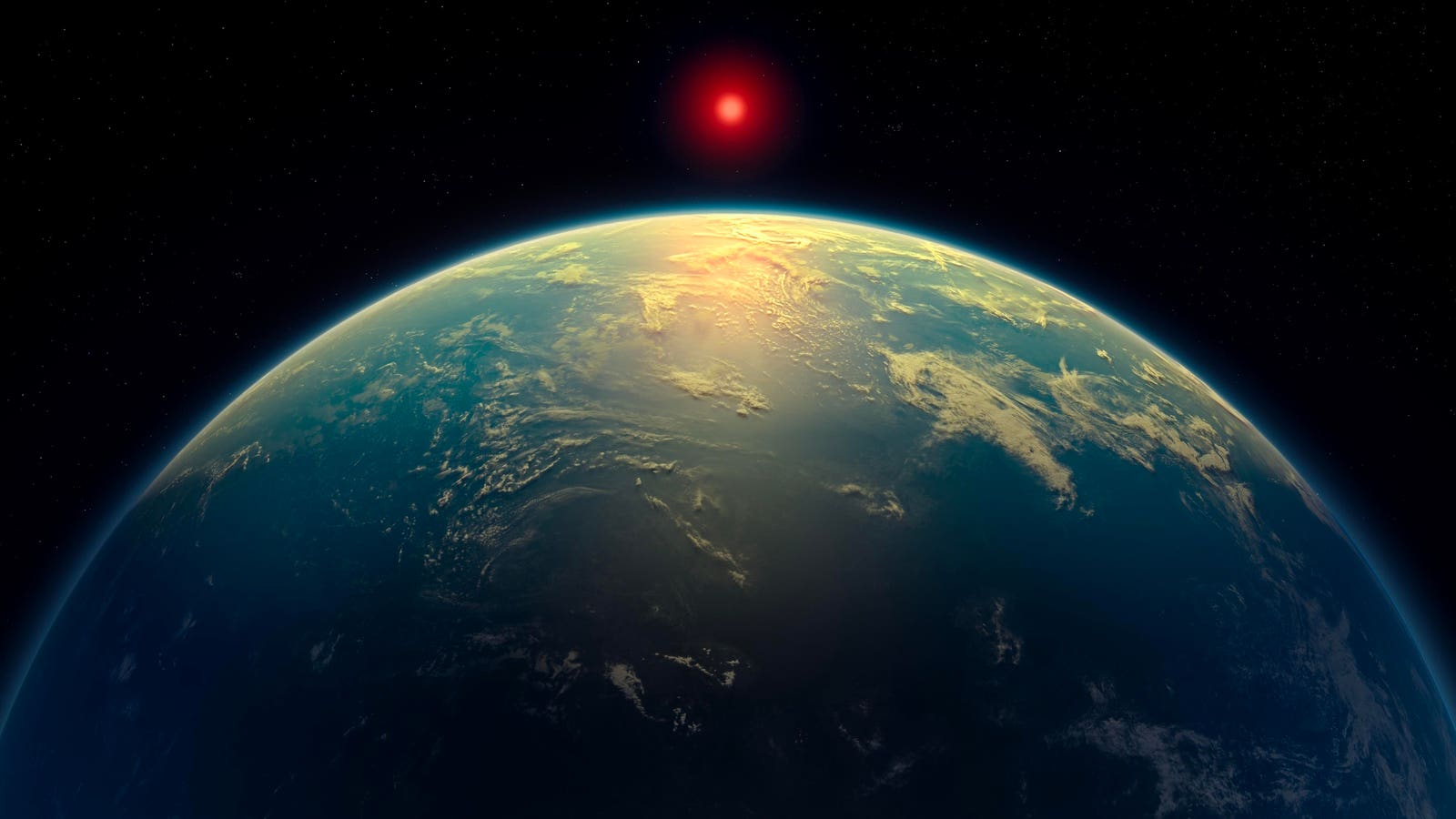Topline
A team of astronomers using the James Webb Space Telescope have detected biosignatures in the atmosphere of a possible ocean world 124 light-years from the solar system. The scientists behind the discovery — confirming a previous detection by Webb — call it the strongest evidence that life may exist outside our solar system. If confirmed, an ocean “teeming” with marine life is possible.
Astronomers have detected the most promising signs yet of a possible biosignature outside the solar … More system, although they remain cautious.
Key Facts
A team of astronomers led by the University of Cambridge in the U.K. found the chemical fingerprints of dimethyl sulfide (DMS) and/or dimethyl disulfide (DMDS) in the atmosphere of an exoplanet called K2-18b. Its atmosphere appears to contain a high concentration of these molecules that are thousands of times stronger than Earths.
The source of these molecules in K2-18b’s atmosphere is unknown, but DMS and DMDS are only produced on Earth by microbial life, such as marine phytoplankton. However, DMS is not always a byproduct of biology, having been found on a lifeless comet. At worst, the biosignatures are the product of an unknown chemical process. At best, it’s a detection of a potential “plankton planet.”
An exoplanet about 2.6 times the size of Earth, K2-18b, orbits a red dwarf star in the so-called habitable zone — where liquid water could theoretically exist on its surface — but it’s no Earth 2.0. The same research team that claims to have confirmed DMS and DMDS on K2-18b is responsible for the concept of “Hycean” planets, which do not exist in the solar system. Others think that K2-18b may be a gas planet, or have an ocean of molten rock.
Further observations using Webb are planned over the next few years, which could confirm the findings, though there’s no way of visiting a planet 124 light-years distant. If traveling at the speed of NASA’s Parker Solar Probe — the fastest-moving spacecraft — it would take approximately 190,000 years to reach.
Why This ‘hycean’ Planet Is Not ‘earth 2.0’
Back in 2021, the same team of scientists identified a new class of habitable exoplanets they called Hycean, explaining that they’re not rocky like Earth, instead having oceans and hydrogen-rich atmospheres. Hycean worlds can also have atmospheric temperatures up to 392 degrees Fahrenheit (200 degrees Celsius) and be tidally locked to their star, with a permanent night-side. K2-18b is the ultimate example of such a planet.
‘an Ocean Teeming With Life’ Best Fits The Data
K2-18b orbits a very active red dwarf star, so its surface is likely drenched in high-energy radiation, which would be more hostile to life as we know it than Earth, according to NASA. However, the concept of Hycean worlds allows scientists to think outside the box and consider if life could exist in completely un-Earth-like environments. “Earlier theoretical work had predicted that high levels of sulfur-based gases like DMS and DMDS are possible on Hycean worlds,” said Professor Nikku Madhusudhan from Cambridge’s Institute of Astronomy, lead author of a paper published this week in The Astrophysical Journal Letters. “And now we’ve observed it, in line with what was predicted. Given everything we know about this planet, a Hycean world with an ocean that is teeming with life is the scenario that best fits the data we have.”
The Truth About K2-18b
K2-18b has been the subject of many recent claims and counter-claims about biosignatures. Discovered in 2015 by the Kepler Space Telescope, it’s long topped a list of exoplanets that should be investigated using space telescopes. In 2019, the Hubble Space Telescope found evidence of water vapor in its atmosphere. In 2023, the same scientists now claiming to have confirmed DMS reported a preliminary detection that “requires further validation.” On that occasion, Webb’s NIRISS and NIRSpec instruments were used. This time, Webb’s MIRI instrument was used.
A ‘tipping Point’ In The Search For Life?
The scientists are not yet claiming a definitive discovery, but state that this latest detection has only a 0.3% probability of occurring by chance. They also state that Webb needs 16 and 24 hours of further observations to reach the 0.00006% probability required. “This is an independent line of evidence, using a different instrument than we did before and a different wavelength range of light, where there is no overlap with the previous observations. The signal came through strong and clear,” said Madhusudhan. “This could be the tipping point, where suddenly the fundamental question of whether we’re alone in the universe is one we’re capable of answering.”
Background
Although they’re not Earth-like, there are reasons why some exoplanet-hunters consider Hycean planets like K2-18b to be low-hanging fruit in the search for life. As well as being larger than Earth, they dominate the known exoplanet population and appear to occur relatively close to the sun, making them easier to locate and study than smaller Earth-sized planets. That makes this latest research even more important in the search for life off-Earth — but it’s not proof of life.
Further Reading
ForbesA Major Meteor Shower Begins This Week: When To See It At Its BestBy Jamie Carter
ForbesUpdated: Northern Lights Alert For 17 States After ‘Double Eruption’ On SunBy Jamie CarterForbesPerseid Meteor Shower 2025: Why You Need To Change Your PlansBy Jamie Carter












